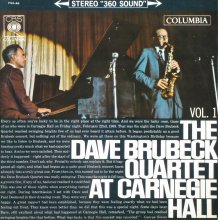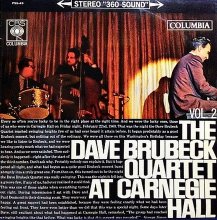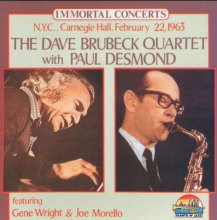
.jpg)
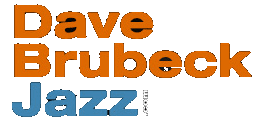
The Dave Brubeck Quartet at Carnegie Hall
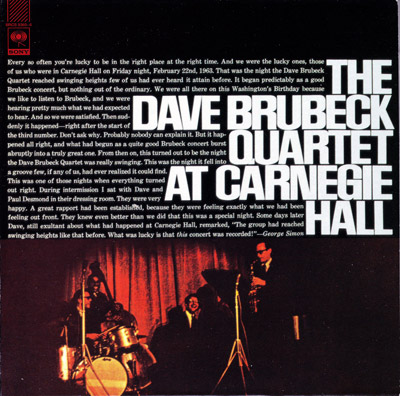
Other Album Covers & Images
Label: Columbia
Year: 1963
Released on LP: Yes
Released on CD: Yes
Tracks
CD 1
1. St. Louis Blues
2. Bossa Nova U.S.A.
3. For All We Know
4. Pennies From Heaven
5. Southern Scene [Briar Bush]
6. Three to Get Ready
CD 2
1. Eleven Four
2. It's a Raggy Waltz
3. King for a Day
4. Castillian Drums
5. Blue Rondo a la Turk
6. Take Five
Personnel
Dave Brubeck (piano)Paul Desmond (alto sax)
Joe Morello (drums)
Eugene Wright (bass)
Notes
1. Suggested by many to be the greatest concert ever performed by the Classic Quartet.
2. Selection 5 - CD 1 is released as “Briar Bush” on Columbia C2K-61455.
3. Originally released by Columbia on 2 LP's- Vol 1 & Vol 2. Columbia subsequently released it on a double LP.
5. CD released by Columbia in 2001 with revised liner notes by Dave Brubeck.
6. A bootleg CD was issued by "Giants Of Jazz" in 1996 but it does not contain the entire concert - “The Dave Brubeck Quartet With Paul Desmond - N.Y.C., Carnegie Hall, February 22, 1963.
7. Released as CD in mini LP format in Japan under the "Sony Master Sound" series - Sony Records SRCS 9365-6.
8. In 1996 Columbia issued " Time Further Out" on CD which included additional bonus tracks of which was "It's a Raggy Waltz" from this album.
Reviews
All Music Guide – CD - Review – copyright
Without a doubt, the concert presented on N.Y.C., Carnegie Hall, February 22, 1963 (1963) is one of the most significant live releases -- not only by Dave Brubeck (piano), but quite possibly from the entire post-bop jazz era. Although the album's moniker indicates February 22 is the show date, according to the show handbill, it was actually held on the 21. While the full-length performance is available on the two-disc Dave Brubeck Quartet at Carnegie Hall (1963), over an hour of highlights can be found on this truncated collection. In the liner essay accompanying the 2000 CD reissue, Brubeck notes Joe Morello (drums) "was recovering from the flu ..." adding the rest of the band were likewise "a bit uptight." You'd certainly never know by listening, as they exceed all reasonable expectations on these eight selections. Rhetoric, you say? The proof is directly evident as the quartet -- which also includes the respective talents of Paul Desmond (alto sax) and Eugene Wright (bass) -- instantly pounce on a rhythmically sinuous reading of W.C. Handy's "St. Louis Blues."
The solos commence with Desmond's swinging give and take with Brubeck and Wright, all of whom are beyond simply inspired, as they push their inventive interaction to a new strata. Along the way, the song is restructured as time-signatures are bandied about at a healthy clip. The quartet is just getting warmed up as "Bossa Nova U.S.A." propels them into extending the comparatively succinct studio arrangement, creating a centrepiece that spotlights their uncanny facility to manoeuvre themselves around the rather involved and multifaceted soundscape.
There is not a remotely substandard outing to be found, although special mention of the closers "Blue Rondo à la Turk" and "Take Five" are practically compulsory, as these are the tunes even the most cursory Brubeck enthusiast will be familiar with. Granted, the Time Out (1959) versions loom large as major crossovers from the genre of jazz into mainstream pop. That said, by taking the tunes beyond the confines of the studio, the enormous breadth and scope inherent in the original compositions are truly revealed. While certainly no substitute for the aforementioned Dave Brubeck Quartet at Carnegie Hall, there are more than a few incandescent examples of the aggregates unparalleled improvisations.
Lindsay Palmer
© Copyright Rovi Corporation
Wiki
At Carnegie Hall is a jazz album by The Dave Brubeck Quartet. It was recorded at the famed Carnegie Hall in New York City on February 21, 1963. It was described by critic Richard Palmer as "arguably Dave Brubeck's greatest concert" and a "truly majestic record that should be in every serious collection"; for Don Mather it is "one of the all time great live jazz performances".
Ironically, original expectations for the concert were low. Not only was drummer Joe Morello recovering from a case of the flu at the time, but New York had been suffering from a newspaper strike, and the group was worried that the attendance would be sparse.
The worries were groundless: the hall was full; the group, whose long history together (the newest member, bassist Wright, had joined four years earlier) had by then made them extraordinarily close-knit, turned in an exciting, sparkling performance. It featured a remarkable level of co-ordination among the members of the group, at the same time as they display a relaxed yet powerful virtuosity. The latter was especially displayed in their numerous extended, yet still melodious, solo improvisations.
High points include a particularly swinging rendition of For All We Know, relaxed and assured versions of Brubeck's odd-meter material (especially Three To Get Ready and It's a Raggy Waltz) and a memorable, powerful, and fascinating drum solo on Castilian Drums where Morello works up from pianissimo finger drumming, thru brushwork, to thrillingly exuberant virtuoso stickwork. The highlight of the concert is a remarkable rendition of the Brubeck classic Blue Rondo à la Turk, which starts off at a seemingly impossible pace, yet later builds in intensity as the tempo first slows for some intense solos, and then doubles again for a thrilling climax.
The album is somewhat unusual because it contains the complete concert; the producer, Teo Macero, noted that "not a note or a phrase of the musical part of the program has been deleted". The only change was to move It's a Raggy Waltz, originally heard after Eleven-Four, to a later position; this was done to allow the concert to fit onto two LP records.
Curiously, however, Macero's claim is only 99% true; the original LP cut the ending of Castillian Drums by one beat. This "missing beat" has been restored on the recent CD reissue. Also, some of Brubeck's announcements (and Macero's introduction) from the stage were replaced (possibly because they were clearer in sound), but the originals remain on the reissue.
The liner notes (by George Simon, jazz critic for the New York Herald Tribune) include extensive comments by Brubeck on each selection.
